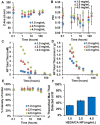Highly Thiolated Poly (Beta-Amino Ester) Nanoparticles for Acute Redox Applications
- PMID: 30674856
- PMCID: PMC6318580
- DOI: 10.3390/gels4040080
Highly Thiolated Poly (Beta-Amino Ester) Nanoparticles for Acute Redox Applications
Abstract
Disulfides are used extensively in reversible cross-linking because of the ease of reduction into click-reactive thiols. However, the free-radical scavenging properties upon reduction are often under-considered. The free thiols produced upon reduction of this disulfide material mimic the cellular reducing chemistry (glutathione) that serves as a buffer against acute oxidative stress. A nanoparticle formulation producing biologically relevant concentrations of thiols may not only provide ample chemical conjugation sites, but potentially be useful against severe acute oxidative stress exposure, such as in targeted radioprotection. In this work, we describe the synthesis and characterization of highly thiolated poly (β-amino ester) (PBAE) nanoparticles formed from the reduction of bulk disulfide cross-linked PBAE hydrogels. Degradation-tunable PBAE hydrogels were initially synthesized containing up to 26 wt % cystamine, which were reduced into soluble thiolated oligomers and formulated into nanoparticles upon single emulsion. These thiolated nanoparticles were size-stable in phosphate buffered saline consisting of up to 11.0 ± 1.1 mM (3.7 ± 0.3 mmol thiol/g, n = 3 M ± SD), which is an antioxidant concentration within the order of magnitude of cellular glutathione (1⁻10 mM).
Keywords: drug delivery; poly (β-amino ester) (PBAE); polymeric nanoparticle; redox; thiol.
Conflict of interest statement
The authors declare no conflict of interest.
Figures





References
Grants and funding
LinkOut - more resources
Full Text Sources

